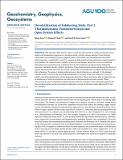Devolatilization of subducting slabs, Part I : Thermodynamic parameterization and open system effects
Abstract
The amount of H2O and CO2 that is carried into deep mantle by subduction beyond subarc depths is of fundamental importance to the deep volatile cycle but remains debated. Given the large uncertainties surrounding the spatio-temporal pattern of fluid flow and the equilibrium state within subducting slabs, a model of H2O and CO2 transport in slabs should be balanced between model simplicity and capability. We construct such a model in a two-part contribution. In this Part I of our contribution, thermodynamic parameterization is performed for the devolatilization of representative subducting materials—sediments, basalts, gabbros, peridotites. The parameterization avoids reproducing the details of specific devolatilization reactions, but instead captures the overall behaviors of coupled (de)hydration and (de)carbonation. Two general, leading-order features of devolatilization are captured: (1) the released volatiles are H2O-rich near the onset of devolatilization; (2) increase of the ratio of bulk CO2 over H2O inhibits overall devolatilization and thus lessens decarbonation. These two features play an important role in simulation of volatile fractionation and infiltration in thermodynamically open systems. When constructing the reactive fluid flow model of slab H2O and CO2 transport in the companion paper Part II, this parameterization can be incorporated to efficiently account for the open-system effects of H2O and CO2 transport.
Citation
Tian , M , Katz , R F & Rees Jones , D W 2019 , ' Devolatilization of subducting slabs, Part I : Thermodynamic parameterization and open system effects ' , Geochemistry, Geophysics, Geosystems , vol. 20 , no. 12 , pp. 5667-5690 . https://doi.org/10.1029/2019GC008488
Publication
Geochemistry, Geophysics, Geosystems
Status
Peer reviewed
ISSN
1525-2027Type
Journal article
Description
Funding: UK NERC Consortium grant NE/M000427/1 and NERC Standard grant NE/I026995/1 (D.R.J). European Research Council (ERC) under the European Union’s Horizon 2020 research and innovation programme (grant agreement no. 772255)Collections
Items in the St Andrews Research Repository are protected by copyright, with all rights reserved, unless otherwise indicated.

